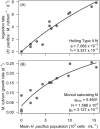Retention of blue-green cryptophyte organelles by Mesodinium rubrum and their effects on photophysiology and growth
- PMID: 39584600
- PMCID: PMC11822877
- DOI: 10.1111/jeu.13066
Retention of blue-green cryptophyte organelles by Mesodinium rubrum and their effects on photophysiology and growth
Abstract
As chloroplast-stealing or "kleptoplastidic" lineages become more reliant on stolen machinery, they also tend to become more specialized on the prey from which they acquire this machinery. For example, the ciliate Mesodinium rubrum obtains > 95% of its carbon from photosynthesis, and specializes on plastids from the Teleaulax clade of cryptophytes. However, M. rubrum is sometimes observed in nature containing plastids from other cryptophyte species. Here, we report on substantial ingestion of the blue-green cryptophyte Hemiselmis pacifica by M. rubrum, leading to organelle retention and transient increases in M. rubrum's growth rate. However, microscopy data suggest that H. pacifica organelles do not experience the same rearrangement and integration as Teleaulax amphioxeia's. We measured M. rubrum's functional response, quantified the magnitude and duration of growth benefits, and estimated kleptoplastid photosynthetic rates. Our results suggest that a lack of discrimination between H. pacifica and the preferred prey T. amphioxeia (perhaps due to similarities in cryptophyte size and swimming behavior) may result in H. pacifica ingestion Thus, while blue-green cryptophytes may represent a negligible prey source in natural environments, they may help M. rubrum survive when Teleaulax are unavailable. Furthermore, these results represent a useful tool for manipulating M. rubrum's cell biology and photophysiology.
Keywords: Hemiselmis pacifica; acquired photosynthesis; ciliate; cryptophyte; functional response; kleptoplasty.
© 2024 The Author(s). Journal of Eukaryotic Microbiology published by Wiley Periodicals LLC on behalf of International Society of Protistologists.
Figures






Similar articles
-
Seasonal succession of ciliate Mesodinium spp. with red, green, or mixed plastids and their association with cryptophyte prey.Sci Rep. 2018 Nov 21;8(1):17189. doi: 10.1038/s41598-018-35629-4. Sci Rep. 2018. PMID: 30464297 Free PMC article.
-
Prey type constrains growth and photosynthetic capacity of the kleptoplastidic ciliate Mesodinium chamaeleon (Ciliophora).J Phycol. 2021 Jun;57(3):916-930. doi: 10.1111/jpy.13131. Epub 2021 May 9. J Phycol. 2021. PMID: 33454988
-
Cryptophyte gene regulation in the kleptoplastidic, karyokleptic ciliate Mesodinium rubrum.Harmful Algae. 2016 Feb;52:23-33. doi: 10.1016/j.hal.2015.12.004. Epub 2015 Dec 29. Harmful Algae. 2016. PMID: 28073468
-
Growth and Chloroplast Replacement of the Benthic Mixotrophic Ciliate Mesodinium coatsi.J Eukaryot Microbiol. 2019 Jul;66(4):625-636. doi: 10.1111/jeu.12709. Epub 2019 Jan 11. J Eukaryot Microbiol. 2019. PMID: 30561091 Free PMC article.
-
Acquired phototrophy in ciliates: a review of cellular interactions and structural adaptations.J Eukaryot Microbiol. 2011 May-Jun;58(3):185-95. doi: 10.1111/j.1550-7408.2011.00545.x. Epub 2011 Apr 21. J Eukaryot Microbiol. 2011. PMID: 21518077 Review.
References
-
- Campbell, L. , Olson, R.J. , Sosik, H.M. , Abraham, A. , Henrichs, D.W. , Hyatt, C.J. et al. (2010) First harmful Dinophysis (Dinophyceae, Dinophysiales) bloom in the U.S. is revealed by automated imaging flow cytometry. Journal of Phycology, 46, 66–75.
-
- Cartaxana, P. , Morelli, L. , Quintaneiro, C. , Calado, G. , Calado, R. & Cruz, S. (2018) Kleptoplast photoacclimation state modulates the photobehaviour of the solar‐powered sea slug Elysia viridis . The Journal of Experimental Biology, 221, jeb180463. - PubMed
-
- Gismervik, I. (2005) Numerical and functional responses of choreo‐and oligotrich planktonic ciliates. Aquatic Microbial Ecology, 40, 163–173.
-
- Gorbunov, M. & Falkowski, P.G. (2004) Fluorescence induction and relaxation (FIRe) technique and instrumentation for monitoring photosynthetic processes and primary production in aquatic ecosystems. In Photosynthesis: Fundamental aspects to global perspectives (pp. 1029–1031). Allen Press Montreal.
MeSH terms
Grants and funding
LinkOut - more resources
Full Text Sources
Research Materials

